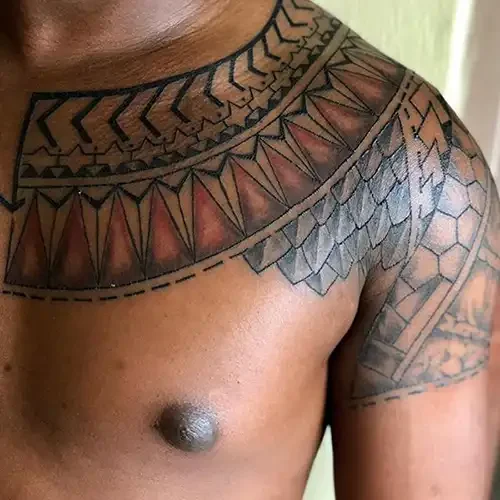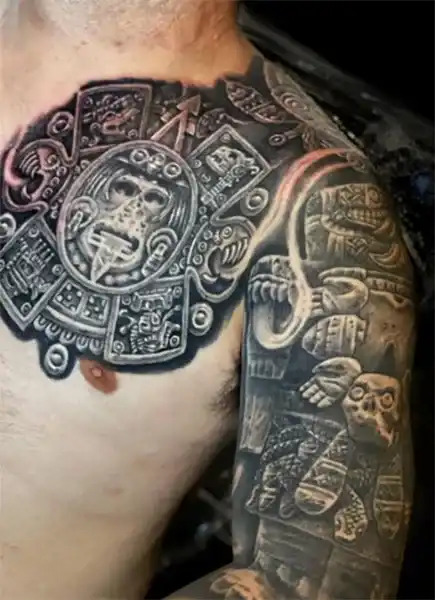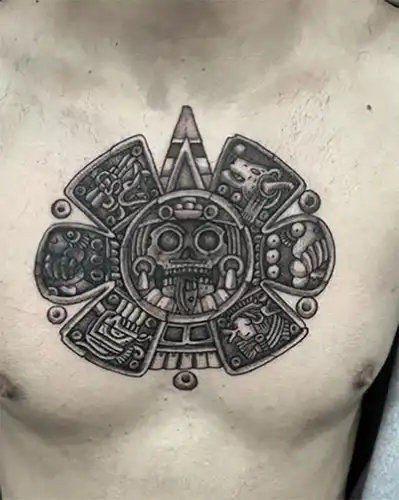Tribal Tattoos in Nairobi, Kenya
Tribal tattoos refer to a style of tattooing that originated from various indigenous cultures around the world. These tattoos are characterized by bold, black lines and geometric patterns that often form abstract or symmetrical designs. Tribal tattoos have a long history and have been practiced by different tribes in places such as Polynesia, Native America, Africa, and Southeast Asia.
Tribal Tattoos
In traditional tribal cultures, tattoos held significant cultural and spiritual meaning. They were used to represent a person’s status, achievements, or affiliation with a particular tribe or community. The designs often symbolized important aspects of tribal life, such as ancestry, spirituality, protection, and personal identity.
Polynesian tribal tattoos, for example, are renowned for their intricate patterns and symbolism. They often incorporate elements like ocean waves, sun, turtles, and other marine creatures, reflecting the deep connection of Polynesian people with the sea. Maori tattoos, from the indigenous people of New Zealand, feature curving and spiraling patterns called “koru” that represent life, growth, and regeneration.
Over time, tribal tattoos have gained popularity outside their original cultural contexts and have been adapted and modified to suit contemporary tattoo styles. Many people today choose tribal tattoos for their aesthetic appeal, without necessarily ascribing to the specific cultural meanings behind the designs.
It’s important to note that while tribal tattoos can be visually striking, it’s crucial to respect the cultural significance behind them. If you’re considering getting a tribal tattoo, it’s advisable to research the cultural context and meanings associated with the specific style you’re interested in. Consulting with a professional tattoo artist who specializes in tribal designs can also help ensure that the tattoo is executed accurately and respectfully.
Tribal Tattoos Design Techniques
Tribal tattoos encompass a wide range of styles and techniques due to their cultural diversity and historical significance. Here are some techniques commonly associated with tribal tattooing:
African
African tribal tattoos encompass a wide range of diverse and culturally rich body art traditions practiced by various ethnic groups across the African continent. These tattoos hold deep cultural, spiritual, and symbolic significance within African societies, and the specific designs and meanings can vary greatly depending on the region and tribe.
African tribal tattoos often draw inspiration from the natural world, ancestral heritage, mythological figures, and spiritual beliefs. They can feature bold patterns, abstract designs, and representations of animals, plants, and sacred symbols.
- Berber Tattoos: Berber tribes in North Africa, such as the Amazigh people, have a long history of tattooing. Their tattoos often incorporate geometric patterns, symbols of protection, and cultural identity markers.
- Ndebele Tattoos: The Ndebele people of South Africa and Zimbabwe are known for their elaborate and colorful geometric tattoos. These tattoos are often worn by women and serve as a form of cultural expression and identity.
- Maasai Tattoos: The Maasai tribe of East Africa traditionally practice scarification, which involves cutting the skin to create raised patterns. These scars serve as markers of beauty, bravery, and social status within the community.
- Yoruba Tattoos: The Yoruba people of Nigeria have a rich tattooing tradition called “ileke” or “pélé.” These tattoos feature intricate designs that often represent deities, ancestors, or personal achievements.
- Ethiopian Tattoos: The Oromo people of Ethiopia have a tradition of tattooing their faces with fine lines and dots. These tattoos are seen as a symbol of beauty and cultural identity.
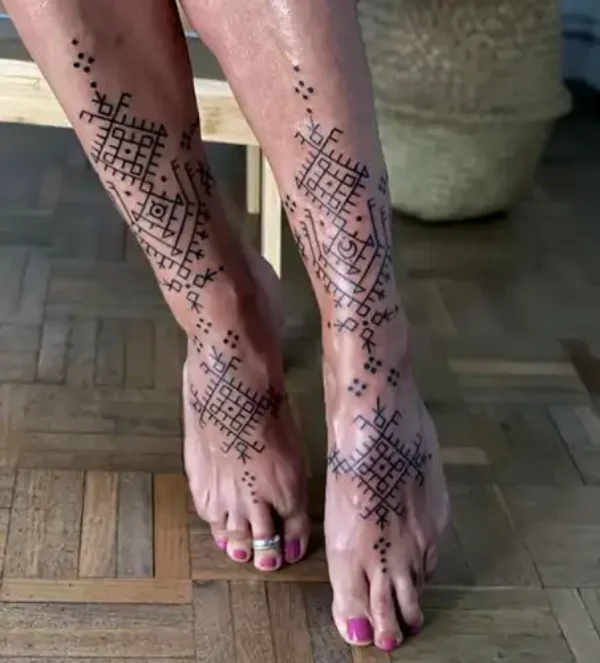
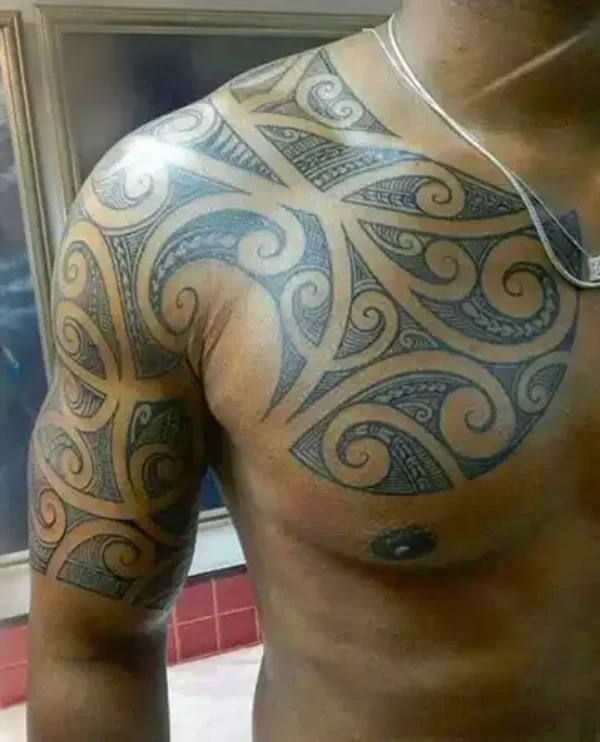
Māori/ Tā moko
Māori tribal tattoos, also known as tā moko, are a traditional form of body art practiced by the Māori people of New Zealand.
Tā moko involves the process of carving or etching the skin using chisels and ink pigment. It is different from other forms of tattooing as it is not applied using a needle and does not penetrate the skin as deeply. Tā moko designs are typically done on the face (moko kauae) for women and on the face and other parts of the body for men.
Each tā moko design is unique and carries personal and ancestral significance. The patterns and motifs used in tā moko often represent the wearer’s lineage, social status, achievements, and connection to their ancestors. They can also symbolize important aspects of Māori cosmology and spiritual beliefs.
Samoan/ Tatau
Samoan tribal tattoos, known as tatau, are an ancient form of body art practiced by the Samoan people of Polynesia. Similar to Māori tā moko, Samoan tatau holds deep cultural and spiritual significance within Samoan society.
Tatau is a traditional art form that involves using handmade tools to apply ink pigment into the skin. The process is done by tapping the tools, which consist of sharpened boar’s teeth or shark’s teeth attached to a bone or wooden handle, into the skin. This method, known as “tapping” or “hand-tapping,” requires great skill and is a testament to the craftsmanship of the tattoo artist.
Samoan tattoos are traditionally applied to various parts of the body, including the back, chest, arms, and legs. These tattoos often consist of intricate patterns and geometric designs, incorporating elements such as lines, curves, and repetitive motifs. The placement, size, and design of the tatau can convey different meanings and reflect the wearer’s social status, achievements, and personal history.
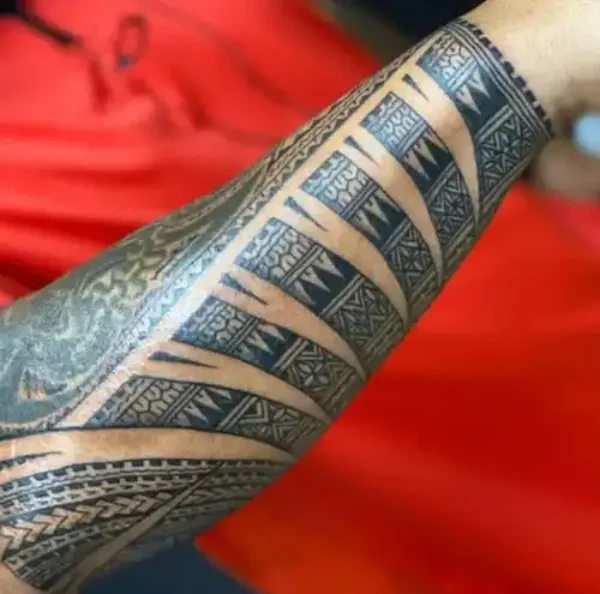





Marquesan/ Enata
Marquesan tribal tattoos, also known as “enata,” are a traditional form of body art practiced by the Marquesan people of the Marquesas Islands in French Polynesia. Marquesan tattoos are known for their intricate and bold designs, often characterized by geometric patterns, flowing lines, and stylized human and animal figures.
Marquesan tattoos have a long history and hold significant cultural and spiritual meaning within Marquesan society. They serve as a visual representation of the wearer’s identity, social status, and personal journey. These tattoos are deeply connected to the rich mythology, history, and traditions of the Marquesan people.
The motifs and symbols used in Marquesan tattoos often vary based on the wearer’s gender, lineage, and personal preferences. The designs can incorporate elements such as turtles, birds, lizards, rays, and other animals, as well as patterns inspired by nature, including waves, leaves, and shells. These symbols are often arranged in symmetrical patterns and placed strategically on the body, such as the chest, arms, back, and thighs.
Hawaiian/ Kākau
Hawaiian tribal tattoos, known as “kākau” in the Hawaiian language, are a traditional form of body art that originated in the Hawaiian Islands. These tattoos are deeply rooted in Hawaiian culture and hold significant cultural and spiritual meaning.
Hawaiian tattoos traditionally feature bold, black designs with geometric patterns and nature-inspired elements. They often incorporate symbols such as waves, sharks, turtles, fish, flowers (such as hibiscus), and other elements found in the Hawaiian natural environment. Each symbol carries its own significance and can represent qualities like strength, protection, guidance, or connection to the land and sea.
In Hawaiian culture, tattoos were not only a form of artistic expression but also served as a means of storytelling and preserving cultural heritage. They were used to convey a person’s lineage, social status, and personal achievements. Tattoos were also believed to offer spiritual protection and connect the wearer to their ancestors.
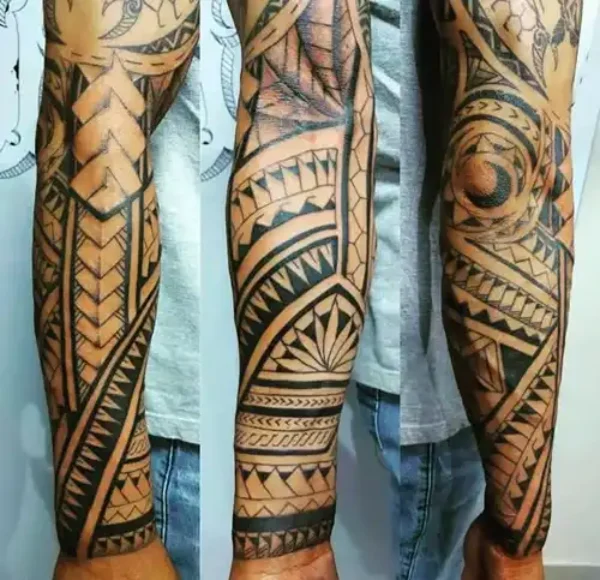


Mayan
Mayan tribal tattoos, also known as Mayan glyphs or symbols, are inspired by the ancient Mayan civilization that thrived in Mesoamerica, particularly in present-day Mexico, Guatemala, Belize, Honduras, and El Salvador. Mayan tattoos draw upon the rich cultural and artistic traditions of the Mayan people.
Mayan tattoos often incorporate intricate geometric patterns, stylized animals, and symbolic glyphs or hieroglyphics. These glyphs represent various concepts, including gods, celestial bodies, natural elements, and important cultural or historical events. Each glyph carries its own meaning and can be combined to tell a specific story or convey a particular message.
The designs of Mayan tribal tattoos can vary widely, depending on the individual’s preferences, cultural connection, and personal interpretation of the symbols. They may be applied to different parts of the body, such as the arms, chest, back, or legs.
It’s important to note that tribal tattoos encompass a wide range of styles and techniques due to the cultural diversity associated with indigenous tribes worldwide. Different regions and cultures have their own unique approaches to tattooing, and it’s essential to research and respect the specific techniques and meanings associated with the tribal style you are interested in. Consulting with a skilled and knowledgeable tattoo artist who specializes in tribal tattoos can help ensure an accurate and respectful representation of the style you desire.
Schedule Appointment
Tribal Tattoos
Where do Tribal Tattoos look best
The placement of tribal tattoos largely depends on personal preference and the size and design of the tattoo. Here are some common areas where tribal tattoos often look visually appealing:
- Arms: Tribal tattoos are commonly seen on the upper arms, lower arms, or even wrapping around the entire arm. The muscular contours of the arms can enhance the bold lines and geometric patterns of tribal designs.
- Shoulders: Tribal tattoos on the shoulders can create a strong and impactful look. They can be extended onto the upper back or chest for a larger and more elaborate design.
- Chest: Tribal tattoos on the chest can be visually striking, especially if you want a larger and more intricate design that covers a significant portion of the chest area.
- Back: The back offers a large canvas for tribal tattoos, allowing for expansive and elaborate designs. Full back pieces or upper back tattoos that extend to the shoulders and neck can be particularly impactful.
- Legs: Tribal tattoos on the thighs, calves, or even around the ankles can create a visually appealing and balanced look. The shape and curves of the legs can complement the lines and patterns of tribal designs.
- Torso/Sides: Tribal tattoos on the sides of the torso, also known as the rib cage area, can be visually captivating. They can be designed to follow the natural contours of the body or incorporated into other tattoo elements on the front or back.
Ultimately, the best placement for a tribal tattoo depends on factors such as the size and complexity of the design, your personal style, and your comfort level. It’s important to consider how the tattoo will interact with your body’s natural shape and movement. Consulting with a skilled tattoo artist can help you determine the most suitable placement for your desired tribal tattoo.
Factors that you should consider when getting a Tribal Tattoos
When getting a tribal tattoo, it’s important to consider several factors to ensure that you make an informed decision and end up with a tattoo that you’ll be happy with for years to come. Here are some key factors to consider:
- Cultural and Symbolic Meaning: Tribal tattoos often have deep cultural and symbolic meanings associated with specific tribes or cultures. Research the origins and symbolism behind the tribal style you are interested in to understand its significance. Ensure that you approach the tattoo with respect and cultural sensitivity.
- Design and Style: Explore different tribal tattoo styles and designs to find the one that resonates with you. Consider whether you prefer bold, black designs or more intricate patterns. Decide if you want a specific tribal style, such as Polynesian, Maori, or Native American, or if you prefer a fusion of different tribal elements.
- Size and Placement: Think about the size and placement of your tattoo. Consider the body part you want to get tattooed and how the size of the design will work in that area. Take into account factors like visibility, how the tattoo will interact with your body’s natural contours, and if you plan to expand the tattoo in the future.
- Skilled Tattoo Artist: Find a skilled tattoo artist who specializes in tribal tattoos. Look for an artist who has experience and knowledge of the specific tribal style you desire. Review their portfolio and ensure their artistic style aligns with your vision. Consult with the artist to discuss your ideas and ask for their input.
- Aftercare and Long-Term Maintenance: Consider the aftercare and long-term maintenance of your tattoo. Tribal tattoos, like any other tattoos, require proper care to ensure proper healing and to maintain the longevity and appearance of the design. Follow the aftercare instructions provided by your tattoo artist and be prepared to commit to the necessary care and maintenance routine.
- Personal Connection: Choose a tribal design that holds personal significance for you. While it’s important to respect the cultural origins of tribal tattoos, finding a design that resonates with your own story, values, or heritage can make the tattoo even more meaningful to you.
Remember, getting a tattoo is a personal decision, and taking the time to consider these factors will help you make an informed choice. At Rebel Inks Body Piercings and Tattoo Parlour we can provide guidance, answer your questions, and ensure that your tribal tattoo is executed accurately and respectfully.
Tribal Tattoos frequently asked questions
Here are some frequently asked questions about tribal tattoos:
What is the meaning behind tribal tattoos?
The meaning of tribal tattoos can vary depending on the culture and region they originate from. In traditional tribal cultures, tattoos often held deep cultural, spiritual, and personal significance. They could represent a person’s lineage, achievements, social status, protection, or connection to a particular tribe or community. It’s important to research and understand the specific cultural context and meanings associated with the tribal tattoo style you’re interested in.
Can I get a tribal tattoo even if I don’t belong to that tribe or culture?
Yes, you can choose to get a tribal tattoo even if you don’t belong to the specific tribe or culture associated with it. However, it’s crucial to approach it with respect and cultural sensitivity. Understanding the history, symbolism, and cultural significance behind the design can help ensure you appreciate and represent the style appropriately. It’s advisable to consult with a knowledgeable tattoo artist who specializes in tribal tattoos to ensure your design is executed respectfully.
Can tribal tattoos be customized or modified?
Yes, tribal tattoos can be customized or modified to suit your personal preferences or to incorporate meaningful elements. Many people choose to incorporate personal symbols, names, or other design elements into their tribal tattoos to make them more unique and personally significant. It’s important to discuss your ideas with a skilled tattoo artist who can work with you to create a design that respects the traditional tribal style while reflecting your individuality.
Do tribal tattoos have to be black and bold?
While traditional tribal tattoos often feature bold black ink, tribal-inspired designs can be adapted to incorporate other colors and shading techniques if desired. Modern interpretations of tribal tattoos may use a wider color palette or incorporate shading and gradients to add depth and dimension to the design. It ultimately depends on your personal preference and the style you’re aiming for. Discussing your ideas with a tattoo artist can help determine the best approach for your desired outcome.
Do tribal tattoos have any specific placement considerations?
There are no strict placement rules for tribal tattoos, but historically, certain cultures and regions had specific placement traditions. For example, Polynesian tribal tattoos were commonly found on the arms, legs, chest, and back. However, in modern times, tribal tattoos can be placed anywhere on the body based on personal preference and the design itself. It’s important to consider factors such as the size of the tattoo, visibility, and your own comfort when deciding on the placement.
Cost of Tribal Tattoos in Nairobi, Kenya
The cost of tribal tattoos can vary widely based on several factors, including the artist’s expertise, the size and complexity of the design, and the location of the tattoo studio. Here’s a detailed breakdown of the factors influencing the cost and estimated prices:
Factors Influencing Cost
- Artist’s Skill and Reputation:
– Experienced Artists: Artists who specialize in tribal tattoos, especially those with knowledge of traditional techniques and cultural significance, typically charge higher rates. At Rebel Inks Tattoos, Tattoo Removal, and Body Piercings Parlour we have experienced artists who offer quality and premium services.
– Emerging Artists: Less experienced artists may offer lower rates, but it’s crucial to ensure their work meets your quality expectations and respects the traditional designs. - Tattoo Size and Complexity:
– Small Tattoos: Simple, small tribal tattoos might be less expensive but still require precision and expertise.
– Large Tattoos: Extensive designs covering larger areas, like the back, chest, or full sleeves, will cost more due to the time and detail involved. - Design Intricacy:
– Simple Patterns: Basic tribal patterns with less detail are generally quicker and cheaper.
– Intricate Designs: Highly detailed and complex tribal patterns take more time and skill, increasing the cost. - Location:
– Geographical Influence: Tattoo prices can vary significantly based on the local cost of living and the tattoo culture in different areas.
– Shop Location: High-end studios in prime locations, such as major cities, may charge more. Rebel Inks Tattoos, Tattoo Removal, and Body Piercings Parlour is located in the heart of the Central Business Disrict (CBD) in Nairobi, Kenya, and is easily accessible to both locals and foreigners in the country - Time Investment:
– Session Requirements: Larger or more detailed tribal tattoos may require multiple sessions, each adding to the overall cost.
Estimated Costs:
- Small Tribal Tattoo: Ksh. 4,000 to Ksh. 6,000
Examples: Small symbols or motifs, such as a small armband or wrist tattoo. - Medium Tribal Tattoo: Ksh. 8,000 to Ksh. 12,000
Examples: Medium-sized patterns on the forearm, calf, or shoulder. - Large Tribal Tattoo: Ksh. 30,000 and up
Examples: Full sleeves, back pieces, chest designs, or thigh tattoos.
Additional Costs
- Consultation Fees: Some of our artists charge for consultations, especially if custom design work is involved.
- Touch-Ups: Initial touch-ups might be included in the price, but additional touch-ups could incur extra charges.
- Aftercare Products: Proper aftercare is essential for healing, and specific products recommended by our artist might add to the overall cost.
Tips for Getting a Tribal Tattoo
- Research the Cultural Significance: Understand the meanings and origins of the design you choose, especially if it is from a culture other than your own. This helps in respecting the cultural heritage and symbolism.
- Choose a Skilled Artist: Look for artists experienced in tribal tattoos and review their portfolios to ensure their style matches your vision. Skilled artists can ensure the patterns are clean and symmetrical.
- Consultation: Discuss your ideas with our artist to ensure they understand your vision and can execute it properly. Custom designs might take more time and thus cost more.
- Consider Placement: Think about how the placement of the tattoo will affect its appearance and meaning. The size and visibility can also impact the cost.
- Aftercare: Follow our artist’s aftercare instructions meticulously to ensure your tattoo heals properly and maintains its quality. Proper care can prevent infections and fading, preserving the tattoo’s integrity.
Tribal tattoos are a powerful and meaningful form of body art with deep cultural roots. The cost can range from Ksh. 4,000 to several thousand dollars, depending on factors such as the artist’s expertise, the size and complexity of the design, and the location. By choosing the right artist and design, you can ensure that your tribal tattoo is both aesthetically pleasing and culturally respectful.
Get In Touch
For more information on the list above and any other special services,please call or come in for free consultation
Testimonials
After he pierced my industrial piercing and seeing his amazing work, I feel even more excited about getting my tattoo with him in January. I’m really looking forward to it!
I am extremely happy with my new 'Safari' tattoo from Eric at Rebel Inks! The quality of the artwork is fantastic. Eric is a true professional and an amazing artist.
The preparation and design process was thorough and collaborative. He was very patient with my specific requests, including making sure all the elements, which hold personal meaning, were perfect.
The service was friendly and highly professional from start to finish. Despite the 8-hour session, Eric was a pleasant person to spend the time with.
The aftercare guidance and follow-up have been excellent and careful, which has made the healing process easy and better than expected.
I highly recommend Eric for anyone looking for a thoughtful, talented, and caring tattoo artist.
I recommend them 💯
I would definitely recommend if you’re thinking of getting a piercing!
The staff were super friendly, explained everything clearly, and made me feel so at ease. They answered all my nervous questions (and I had many questions),
They walked me through the whole process, gave detailed aftercare instructions, and even followed up afterward to check how I was healing 🫶
Clean, professional, and full of good vibes.
Would 100% recommend . Definitely making a second trip here.
This was the second tattoo I got and I wish I could have come to Eric for my first one! He gave me really great after-care directions for the tattoo as well as a little jar of his own Vaseline-type stuff to put over my tattoo while it was healing! He even put second skin over my tattoo so that I didn’t have to worry about it for the first few days. Now THAT’S good service. My first tattoo artist didn’t do none of that lol.
After the session Eric didn’t rush me and my friend out, he chatted with us and even when he found out I was an artist too— really encouraged me to keep creating and to find a community of artists to support me. I almost cried because I’ve had such a hard time with my own art the past couple of years, it meant so much to me to have a fellow very talented artist say that to me. 🤍🤍🤍
Eric you’re amazing, don’t ever stop creating and just know you’ve impacted lives all over the world!🫶🏻 thanks so much for everything!!
From the moment I walked in, Eric was professional, welcoming, and attentive. He made sure I was comfortable throughout, provided everything I needed, and explained every step of the process. The tattooing itself was unbelievably smooth - I genuinely felt no pain compared to my previous tattoos over the last 22 years.
Eric also gave me excellent aftercare guidance and products, and thanks to that, my tattoo healed beautifully. The attention to detail, precision, and shading are absolutely stunning. This is hands-down the best tattoo I've ever had, and I will be flying back to Nairobi for any future ink.
If you want incredible art, a professional experience, and a talented artist who truly cares about his clients, Rebel Ink is the place to go!
From start to finish, the service was exceptional. The piercer was professional, knowledgeable, and made me feel completely comfortable. The cleanliness of the place was above and beyond — everything was spotless and hygienic, which really put me at ease. Highly recommend for anyone considering a piercing!
Shout out to Eric😘
We ended up changing the jewelry three times to ensure I had the best fit and avoided any signs of rejection, and he always listened to my suggestions as a client, which I really appreciated. Now, three months in, my piercing is healing beautifully, with no sign of rejection. Highly recommend for anyone who values a piercer who cares about your comfort and healing journey!
What stood out the most was the aftercare Eric checked in with me even three weeks later to see how the tattoo was healing. That kind of follow-up shows how much he truly cares about his work and his clients.
I’m very satisfied and will definitely be coming back for my next piece. Highly recommend!
The piercing wasn't as painful as I had thought and the process was quick and satisfactory. I love it!!!
The piercing is healing well thanks to the aftercare instructions and follow-up. I would highly recommend Rebel Inks
Eric also did a belly button piercing for a friend, guiding her through the process, doing the piercing and then explaining the after care to her.
The shop is on the 3rd floor, with the entrance to the stairs near an alleyway on the left. The shop is perfect size, clean, and attractive looking. The mural is pretty dope.
Thank you for the amazing service! 🔥👅✨
I got piercibgs there and the process was really good. My biggest concern was hygiene but that wasn't an issue at all, they use new needles and they sanitize them.
The service itself was also welcoming.
I was informes of everything i needed to know beforehand.
10/10 would recommend!
Eric was so calm and patient with my almost 2 year old lady. It was such a clean and hygienic process. We will definitely be back for our second rounds of piercings and maybe even another tattoo!
They assess the area before any art and advise one accordingly. They also give one post clean up process and also do a check up after the body art projects. Overall, I loved my experience and I’m hooked. 👍
Will definitely come back next time I’m in town 🙂
He listened to what I actually wanted and made sure he could fit in the time before I flew back home.
The shop is clean & private and is easy enough to find.
Eric has even checked in a couple of times since to make sure all is good.
I would totally recommend Eric! I absolutely love my Elephants!
I had a very easy healing period and always follow up from Eric to check on my progress...I would highly recommend if you are a first timer because from my experience all went very well and attention to detail
Thank you for a good job and looking forward to send all my friends your way
And all the best with the new year 2025!
From the moment I walked in, the staff was super friendly and made me feel at ease. The studio had a clean, professional atmosphere, which immediately put me at ease. My piercer was incredibly skilled and explained every step of the process, ensuring I was comfortable the entire time. The piercing was quick and practically painless, and the aftercare instructions were clear and easy to follow. I can tell they really care about the health and safety of their clients.
Overall, a fantastic experience—I highly recommend Rebel Inks and Tattoos for anyone looking to get pierced or tattooed!
They do follow up after their services
Eric's Studio isn’t just a place to get a tattoo—it’s an experience. The combination of professionalism, artistic talent, and a welcoming environment makes it a standout destination for anyone considering a tattoo.
I highly recommend Eric’s Studio to both first-timers and seasoned tattoo enthusiasts. If you’re looking for a high-quality tattoo and an enjoyable experience, this is the place to go.
I would definitely recommend their services again and again
Thank you Rebel Ink
My piercings are healing ❤️🩹 well
I would 💯 recommend
I will definitely come back for more .
Two, all the equipments he used for the piercings were new and/or sterilised.
Three, the parlour itself was very clean and was up to par with the hygiene standards.
Four, Eric provided effective aftercare instructions, making sure I knew exactly how to take care of my new piercings and he kept in touch and continues to do so, to check on the healing progress.
I highly highly highly recommend this place!!!
Would definitely recommend them to friends and go back for other piercings
Not only was the piercing process smooth, but he also provided thorough aftercare instructions, making sure I knew exactly how to take care of my new piercings. What really impressed me was that he keeps in touch to check on how the healing is progressing – a sign of true care for his clients.
The shop maintains a high standard of hygiene, and the atmosphere is welcoming and comfortable, which really added to the positive experience. I highly recommend this place to anyone looking for a professional and caring experience. I’ll definitely be coming back for any future piercings!
My appreciation for the excellent customer service I received. The follow-ups were prompt, and I truly appreciated the gentleness and professionalism throughout. Thank you!"
"Looking for professional eyebrow microshading removal? Look no further!"
The customer care is top tier 👌🏾👌🏾.
Wonderful place to get tattoos and piercings. 💯💯
Eric goes ahead to follow up on his clients progress and gives good advice each time I reach out to him.
I would recommend Reble tattoos anytime.
Good job bro we really appreciate.
Ohh and the price is very fair.
The environment was clean , procedure was sterile and the jewelry used are of the best quality.
He followed up with me during the healing process, he educated me on what I needed to do for my aftercare.
Eric is confident, skilled , experienced and the best piercer. Highly recommend Rebel inks.✨
Definitely recommend!
Great experience.
Eric definitely know what he is doing .
I got exactly what I wanted 2 tiny tats on the same finger .
He was kind and patient throughout the session.
Healing process has been good .
Aftercare services were given and regular checkups on the healing process were done.
I would 💯recommend.
Eric gave me the best reception as it was my first time there,and made me trust him all the way. I appreciate good services.
There services are also affordable not to forget 😊.
He was also invested in the aftercare and would ensure I follow the do's and don'ts in taking care of the tattoo and ensuring proper healing and maximum ink retention.
Would highly recommend Rebel Inks Tattoos.
Rebel Inks Tattoo offer the best,affordable and quality tattoo removal services.If you have unwanted ink,choose Rebel Inks Tattoo,they're the best of the best and the professionalism is a top notch.They ensure you're free from unwanted ink with their Laser Tattoo Removal Technology...
I did a Laser Tattoo Removal with them and i can attest they're the best....
Kudos Eric...
I highly recommend.
It was a generally good experience with good hygiene during the piercing process and has been a smooth healing process.... 10/10
tips. Highly recommend 👍🏽
100% recommendable.
I was particularly impressed with Eric's attention to hygiene. He thoroughly cleaned the room before I entered, sanitized all of the equipment he would be using, and changed gloves between each ear. This level of cleanliness gave me great confidence in his professionalism.
Eric's commitment to customer service did not end on the day of the piercing. He followed up with me regularly throughout the healing process to ensure that I was following the aftercare instructions and that my earlobes were healing properly.
I highly recommend Rebel Inks to anyone in Nairobi who is considering getting a piercing. Eric is a highly skilled and experienced piercer who takes great pride in his work.
So I Check all the boxes below and more:
Customer Care: ✔️
Professionalism : ✔️
Cleanliness ✔️
Price: ✔️
After care service ✔️
Thanks and good job, Eric
The place is neat and clean and the equipments he used were also fine standards. Really appreciate his following up with me on the healing 🤗
I WOULD HIGHLY RECOMMEND THEIR SERVICES to everyone. Actually what you see on their website is EXACTLY what you will get. Keep up the good work Rebel inks Tattoos.
The infection is now gone. I would definitely recommend!
Can recommend this place totally and would go back there anytime!
Thanks!
OUR LOCATION
Areas We Serve
NAIROBI
KIAMBU
KAJIADO
MACHAKOS

